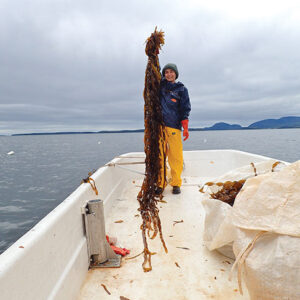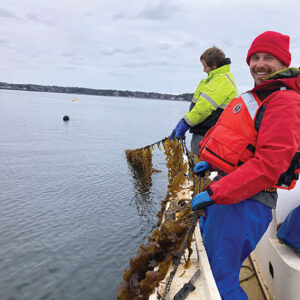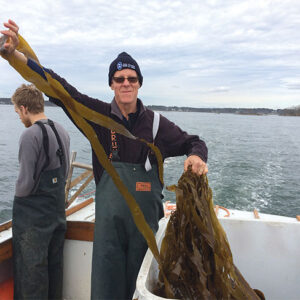
The problem solvers: Seaweed farming challenges
May 24, 2023
By Lynn Fantom
Farmers, educators, researchers, and engineers take on the challenges of seaweed farming
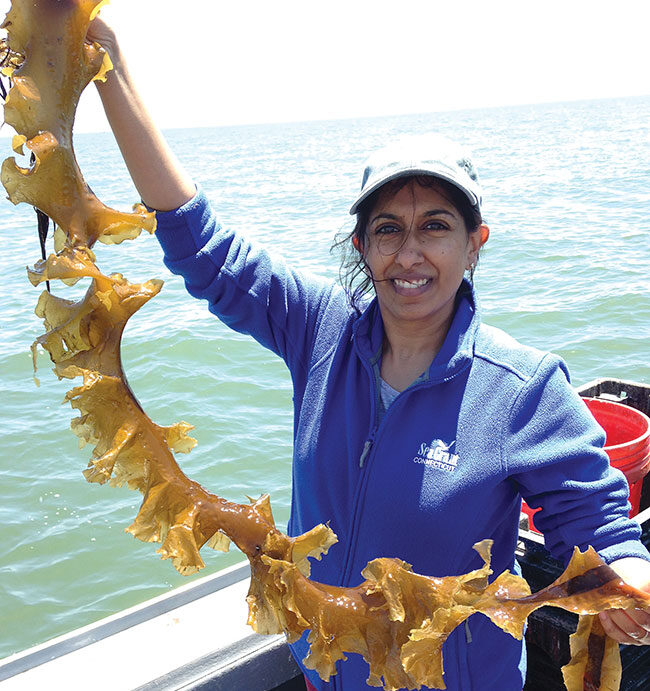 Anoushka Concepcion, an associate extension educator focusing on marine aquaculture with Connecticut Sea Grant, leads the National Seaweed Hub, a collaborative effort of 11 Sea Grant programs ranging from small states like Rhode Island to large ones like Alaska.
Photo: Connecticut Sea Grant
Anoushka Concepcion, an associate extension educator focusing on marine aquaculture with Connecticut Sea Grant, leads the National Seaweed Hub, a collaborative effort of 11 Sea Grant programs ranging from small states like Rhode Island to large ones like Alaska.
Photo: Connecticut Sea Grant Seaweed farms in North America produce a tiny percentage of global output. But as this nascent sector of aquaculture takes a steadfast hold, the challenges to scale have become clearer. And with that have emerged problem solvers who are making incremental but key gains to drive industry growth.
In North America, seaweed is an US$11 billion market, according to Grand View Research, and it’s growing. But most seaweed is imported from Asia for food applications, including thickeners for everything from ice cream to toothpaste.
“Demand is definitely here,” said Anoushka Concepcion. She leads the National Seaweed Hub, a collaborative effort of 11 Sea Grant programs in the US that addresses the emerging needs of the industry—which is also growing.
Today, over 60 farms are active from Alaska to Rhode Island and from Maine to Baja California, Mexico. Most grow kelp in the open ocean, although a handful of land operations cultivate species like dulse and ulva. What are the challenges? Processing capabilities, long-term nursery production, and competition with imports are among them, Concepcion says. And there’s progress in solving them.
A pipeline of farmers
The earliest seaweed farmers have come from the aquaculture community and the traditional working waterfront, such as the wild salmon fishery in Alaska or lobstering in Maine. These two states, in fact, now lead seaweed harvests in the US.
But in a state like Connecticut, which is close to New York City, “interest in seaweed farming is coming from non-aquaculture folks. They see something on TV or in a magazine or a newspaper and that piques their interest. So, at Connecticut Sea Grant, we have inquiries from business people or people who work on Wall Street who are looking for a different way of life,” said Concepcion, who is an associate extension educator focusing on marine aquaculture with the Connecticut Sea Grant Program.
Suzie Flores is one of those farmers. She and her husband Jay started Stonington Kelp Co. in 2017. But for almost a decade prior, Suzie had worked in marketing in New York, climbing the corporate ladder at corporations like McGraw-Hill.
Growing the fresh market
Now she has turned her skills toward developing a strong market for fresh kelp. Her web site offers “sugar kelp cultivated in the pristine and high-energy waters of Fisher’s Island Sound.” Capitalizing on how consumers value fresh, seasonal produce, the headline touts “March-June Only.” Stonington Kelp harvests to order and delivers regionally for recurring orders.
Social media is also part of this farm’s marketing platform. Instagram encourages restaurants to place their orders in advance. And Flores isn’t the only one doing this.
“I think the market interest in fresh sugar kelp is increasing only because of the efforts of kelp farmers themselves,” noted Concepcion. “They are marketing themselves and a product that is high-quality, fresh, food-safe and local—not imported and processed. They’re driving something that should be demanded. Essentially, they’re telling restaurants, ‘You’re missing out on something really, really cool.’”
Building a year-round business
Even as the market expands for fresh product, the industry still faces the daunting challenge of limited processing capabilities and equipment. Plus, it’s labor-intensive. “You get a lot of biomass that needs to be processed in a very short period of time,” said Concepcion. “Then facilities aren’t utilized for a long time. It’s hard to justify.”
There is also the need for long-term safe storage so that farmers can provide access to kelp beyond the two-month harvest season. It cannot be co-mingled with shellfish because shellfish is an allergen, she notes. Some savvy processors have turned to tobacco and apple barns which are vacant in the spring.
Backed by investors committed to reshaping the food environment and supporting women-led businesses, market leader Atlantic Sea Farms has addressed many of these challenges at its 27,800 square feet facility in Biddeford, Maine, which opened in 2021. Processing, product development, and scaled-up manufacturing of frozen and fermented products all occur under one roof.
Atlantic Sea Farms also keeps pushing its retail distribution channels with new products like the Sea-Veggie Burger, which won one of only seven “Best New Products” awards from Nosh.com last winter.
Atlantic Sea Farms customers are getting a taste of what it’s like to eat seaweed year-round, in addition to seasonally fresh at local restaurants. And it tastes a lot better than the imports.
Beyond kelp: red seaweeds
Another Maine-based operation is exploring opportunities beyond kelp. Sarah Redmond, co-owner of Springtide Seaweed, believes dulse and nori can be important new crops for commercial aquaculture and has convinced others of that—namely, the U.S. Department of Agriculture (USDA).
But farming dulse and nori must overcome hurdles, including a reliable seed supply and knowledge of how to cultivate crops for commercial production. Redmond started work on these in 2020.
First, to develop critical nursery technologies and techniques, she tested an innovative approach to sterilize seawater and developed reliable seedstock which would thrive in ocean farms.
Moving forward in the second phase of the project, she is refining the modular turnkey nursery system developed for seed production. She is also continuing to test cultivation substrates, as well as net designs and configurations. Springtide’s USDA small business award of US$650,000 extends through this summer.
Redmond has also cracked the code on processing and storage with operations housed in a former fish cannery. She and business partner Trey Angera run the largest organic seaweed farm in North America.
Need for seed
Nursery production also remains a challenge for kelp farming. “Just in Connecticut as an example, we cannot find reproductive tissue, source tissue, as readily and as easily as we were able to maybe five, 10 years ago,” said Concepcion.
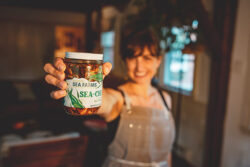
Briana Warner, CEO of Atlantic Sea Farms, has driven new product development with award-winning kelp-based items like fermented seaweed salad, a mild kimchi dubbed “Sea-Chi” (shown here), and Sea-Veggie Burgers in ginger sesame and basil pesto flavours.
Photo: Atlantic Sea Farms
An important step forward was the work of Dr. Charles Yarish, now retired, and his students at University of Connecticut (UConn), who collected over 1,200 algae specimens from 2018 to 2022. Last summer, the collection was licensed to Woods Hole Oceanographic Institution in Massachusetts and to the National Center for Marine Algae and Microbiota (NCMA) at Bigelow Laboratory for Ocean Sciences in Maine. In addition, Bigelow will be receiving collections both UConn and Woods Hole Oceanographic Institution (WHOI) made along the US northeast coast as part of a program funded by the Department of Energy’s Mariner ARPA-E.
The NCMA will maintain, market, and distribute (for a fee) the germplasm for research and commercial use. It was founded in 1980 explicitly to be “the home for soon-to-be orphaned microalgae” and over the years has expanded its mission to be “algae agnostic,” said Dr. Mike Lomas, a marine biogeochemist who serves as director of the NCMA.
One might say it’s now the Amazon of Algae, with listings on an “e-commerce compliant” website and a customer base in 58 countries. “Anyone with computer access and a credit card can buy our microalgae anywhere in the world,” said Lomas. NCMA also manages licensing options.
Following some “germplasm housekeeping,” the Yarish macroalgae collection is being “slowly rolled out to the website” and will be available mostly in New England, in compliance with regulations.
“It’s really key to have a stable germplasm for algae,” said Lomas. “If we’re going to have an algal bioeconomy, we need an algal germplasm.”
“Nurseries can go to the germplasm bank and just order the strain that’s native to the growing area—and leave the wild populations alone,” added Concepcion. “From a commercial perspective, I think this will change production of seaweed forever, especially in the United States.”
Overcoming regulatory barriers
Development of infertile breeds of domesticated kelp would help overcome another challenge: the limitations on selectively bred and improved strains. Currently, most national and state regulators prohibit them because of concerns about potential impact on natural resources.
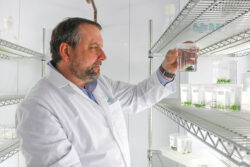
Dr. Mike Lomas, a senior research scientist at Bigelow Laboratory for Ocean Sciences in Maine, directs the laboratory’s National Center for Marine Algae and Microbiota, which maintains the largest and most diverse collection of publicly available marine algal strains in the world. Photo: Bigelow Laboratory for Ocean Sciences
Researchers at Woods Hole Oceanographic Institution (WHOI), in collaboration with teams at UConn and University of Southern California, have developed a technique to identify pairs of parents that will produce “sporeless” or sterile offspring. Such a cross can be achieved within one generation using gene sequencing that spots natural mutations which control fertility.
“In order for U.S. kelp farms to continue growing and competing internationally, modern plant breeding, genetics, and agronomic practices must be adopted in an environmentally responsible way,” according to WHOI’s Scott Lindell.
The real-world value of this research earned the Lindell-led team a Gold Innovation Award for seaweed solutions at the international Seagriculture Conference last year in Maine.
Automation to save time and toil
Seagriculture’s Silver Innovation Award went to a WHOI team led by research associate David Bailey and including engineers Robin Littlefield and Ben Weiss. Working to reduce labour on farms in Kodiak, Alaska, they developed an automated underwater seaweed seed-string deployment device.
With this invention, for which a patent is pending, one farmer loads two seed spools on to an automated line seeder and attaches it to the grow-line with quick-connect clips. Thrusters, activated with a waterproof switch, propel the device across the line until it reaches the end, when the thrusters are deactivated. A farmer on the opposite side secures the seed-string and detaches the device. The process repeats on the next line in the reverse direction until the entire farm is seeded.
Seeding is much faster than traditional methods, a big advantage during harsh weather, and boats do not consume as much fuel. Another important benefit: the seed itself spends seconds not minutes in the air, which boosts survival.
